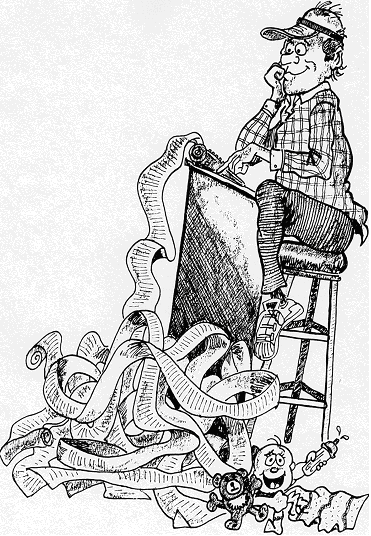
We first survey the plot, then draw the model;
And when we see the figure of the house,
Then we must rate the cost of the erection;
Which, if we find outweighs ability,
What do we then but draw anew the model.
- William Shakespeare
A Cost Analysis is a comprehensive breakdown of all expenditures related to the Design/Build process. The following list is a line item representation for a typical residential project combining hard and soft costs. Strive for accuracy as each item is assigned a cost by bidders. Assigning accurate costs will be an extension of estimating activities except these numbers will be based on Trade Contractors' and Suppliers' bid proposals.
WITHOUT any formal contracts or binding agreements, an Owner can solicit proposals from a Trade Contractor or Supplier for each type of work to be performed. You will need copies of Drawings and Specifications to circulate among bidders so be prepared to own a set of six to eight copies. Remember: Two copies will eventually be submitted to the building department for their review so keep these in clean condition.
Whether you purchase stock Drawings from a plan service or hire an Architect to create an original design, either way be sure to attach a copy of your Specifications to each set, then Trade Contractors will make proposals based on same product types, sizes, and quality.
After the first round of proposals, you will be able to embellish your BUDGET ESTIMATE with details provided by the people who will actually do the work and provide the materials. All items of the COST ANALYSIS will be a greater elaboration of your original idea of what your project would likely cost.
A second round of bid proposals from different Trade Contractors and Suppliers will add a competitive edge to this endeavor as each business attempts TO WIN your contract. The following list expands on the basic categories covered in your BUDGET ESTIMATE. What now occurs is a more thorough COST ANALYSIS as you begin to collaborate with the entire Building Community.
This list is also available to you in an Excel format:
DESIGN / BUILD BUDGET EXCEL SPREADSHEET
HARD AND SOFT COSTS
- Architect/Designer's Fee
- Site Survey
- Permits:
- Building
- Water
- Septic/Sewer
- Electric
- Plumbing
- HVAC
- Install Electrical Service
- Install Water Service
- Excavation
- Hauling
- Environmental Protection
- Framing Labor & Lumber
- Framing Hardware
- Sealants & Adhesives
- Concrete Labor & Materials:
- Pads
- Footings
- Walls
- Floors
- Sidewalks
- Steps
- Patios
- Driveways
- Drain tile and/or Dispersal Trench for Storm water Control
- Downspout Drains
- Damp and/or Waterproofing
- Reinforcing Steel
- Anchor Bolts
- Sheet Metal Flashing
- Backfill
- Exterior Doors:
- Pre-finished
- Pre-hung
- Handles
- Deadbolts
- Thresholds
- Asphalt Paving
- 23. Roofing:
- Felt Paper
- Flashing
- Vents
- Shingles
- Garage Doors
- Windows and Skylights
- Doors:
- Sliding
- Specialty
- Shower
- Include Hardware
- Include Finishes
- Mirrors
- Medicine Cabinets
- Glass & Glazing
- Brick Veneer or Masonry
- Stone Veneer
- Fireplace/Wood Stove
- Chimney/Vent Stack
- Insulation Material & Labor:
- Foundation
- Floor
- Walls
- Ceiling
- Fire Stuffing
- Weatherproofing
- Soundproofing
- Plumbing:
- Rough-in/Service Connection
- Finish
- Hot Water Tank
- HVAC:
- Rough-in/service Connection
- Finish
- Gas or Oil Piping
- Oil Tank
- Radon Gas
- Electric:
- Rough-in/service Connection
- Finish
- Fixture Allowance
- Hanging Fixtures
- Sconces
- Hair Dryer
- Vent Fans
- Heat Lamps
- Appliance Allowance:
- Cook top & Hood
- Oven
- Microwave
- Refrigerator
- Dish Washer
- Garbage Disposal
- Clothes Washer
- Clothes Dryer
- Finish Labor & Lumber (Millwork Package):
- Case & Base
- Window Liner
- Specialty Trim
- Half or Full Jambs
- Sauna Kit
- Shelf & Ledger
- Interior Doors Material & Labor:
- Pre-finished
- Pre-hung
- Include hardware
- Panel
- Flush
- Bi-Fold
- Bi-Pass
- Drywall Material & Labor (Gypsum Wallboard):
- Hang
- Tape
- Finish/Curing
- Seal & Texture
- Cabinets Material & Labor:
- Kitchen
- Laundry
- Bath
- Entertainment
- Office
- Exterior Finish Material & Labor:
- Gutters & Downspouts Material & Labor
- Paint & Stain Material & Labor:
- Interior
- Exterior
- Trim Pkg
- Door Pkg
- Window Pkg
- Cabinet Pkg
- Wall Coverings Material & Labor:
- Paper
- Fabric
- Mirror
- Wood Panel
- Floor Coverings Material & Labor:
- Vinyl
- Tile
- Stone
- Marble
- Hardwood
- Carpet
- Cabinet Countertops:
- Laminated Plastic
- Solid Surface
- Hardwood or Tile
- Septic System Material & Labor:
- Percolation
- Design
- Installation
- Storm Water Material & Labor:
- Leach Field
- "French" Drain
- Culvert
- Perforated Tile
- Finish Hardware
- Ornamental Iron/Specialty Metals
- Deck Material & Labor
- Structural
- Surface
- Guardrail
- Stair
- Handrail
- Landscape Material & Labor
- General Labor
- Construction Consultant
- Clean-up
- Recycle/Refuse
- Broom & Bags
- Builder's Overhead and Profit
- Professional Service's Fee
(Construction Manager/Lawyer/Accountant/Engineer)
You are NOT expected to figure material and labor costs for each line item of the Cost Analysis BY YOURSELF. The Owner's job is to assemble Drawings and Specifications then request bids from and negotiate contracts with Trade Contractors and Suppliers for the work to be completed on your project.
If this seems overwhelming, another option is to work directly with a General Contractor because his/her reputation is based on an existing organization of Trade Contractors and Suppliers. HOWEVER, as an ownerbuilder, you're expected to be fully responsible for all GC duties!
Even though you won't be calculating specific material and labor costs, it may be helpful to understand how bidders arrive at a price for the work to be completed. Generally, most pricing systems fall into one of three categories: Square Foot, Assembly, and Unit Pricing.
Square Foot pricing is the least accurate, but less time consuming to prepare. This method determines total square footage of an area and assigns an average dollar amount per square foot of that area.
Assembly pricing is more accurate, and it takes into consideration an entire component of construction, such as a roof truss assembly, and arrives at a more detailed cost of the pieces for that component.
Unit Pricing is the most accurate, but the most time consuming to prepare. It takes into account every item which needs to be purchased and installed for an entire phase of the work.

R.S. Means Company has developed a construction cost data base covering all phases of residential construction. The data base is organized into trade sections covering square foot cost, assemblies cost, and unit price cost. Costs are broken under headings for material, labor, equipment, overhead, and profit. Since these are "average" costs, the Means Residential Cost Data Guide has factored a number of variables affecting costs such as quality, productivity, size of project, and location. There's also a list of other unpredictable factors covered in the book's content which may be useful for identifying less than ideal conditions on your project. Cost data guides from R.S. Means are also available for remodeling and refurbishing homes.
Referring to a residential construction data base is a good way to weigh and consider the bid proposals which are being submitted. Just be sure your cost analysis thoroughly covers all items in the Drawings and Specifications because the bid proposals form the basis of your Contract Documents. You may also want to consult with a Certified Public Accountant familiar with the construction industry for professional advice regarding Cost Analysis.
You'll be determining what offer to accept based on price, quality, service, and compatibility. Your relationship with Trade Contractors and Suppliers isn't conditional upon lowest bidder. Your relationship is also based on adherence to Specifications and how well the bidder conforms to the conditions under which the work will be performed.
Remember: This is an opportunity for ANALYSIS and NEGOTIATION!
| 



